
Transporting large shipments of cargo by sea is still a major feature of the supply chain, even in today's increasingly agile and granular environment. Improving operations at ports and in the general shipping segment may be a vital efficiency-enhancing feature of future strategies. From manufacturers and retailers to the shippers and port operators that provide capacity, every stakeholder in this industry could benefit from modernization efforts. Fortunately, the same tech tools that have revolutionized other kinds of logistics can have a notable effect on the port ecosystem.
The amount of progress made in creating more agile, intelligent and tech-enabled ports will likely depend upon the level of connectivity achieved between shippers, ports and businesses. Getting systems to work together may inject visibility into the traditionally ponderous world of global shipping. Data is the currency of the modern supply chain, and connectivity is the primary virtue possessed by today's leading logistics organizations.
Enhancing the world's ports
Cutting through the overwhelming complexity of the port ecosystem may prove to be a game-changing supply chain development. A recent Port Technology paper by the World Economic Forum's Wolfgang Lechmacher explained the path port solutions may take in the years ahead. The use of better data links in shipping infrastructure will ensure companies don't lose visibility into their increasingly intelligent and connected supply chains when goods arrive in ports. Leaders will make upgrades to their computing power to ensure they don't create "friction" in the data flow.
Automatic decision-making based on artificial intelligence has become a much sought-after capability in various supply chain locations, and big data analytics programs are taking on elevated roles. Lechmacher suggested port ecosystems have to become the kinds of data-rich environments that will assist companies pursuing these high-powered processes elsewhere up and down their overall supply chains.
With enough data flowing through port ecosystems, automated decision-making could take hold among the shipping containers. When cranes use internet of things data input to know intuitively which shipments to move where and when, all companies involved save time. Removing human decision points from day-to-day operations is one way to streamline the port ecosystem on the whole and keep cargo moving smoothly.

The same kinds of tech tools that are making ports more effective and intelligent are creating end-to-end benefits at sea, according to Material Handling & Logistics. The news provider quoted ABI Research's Susan Beardslee, who sees a future of increased tech implementation and standardization empowering large shipping firms as they attempt to drive greater profits from their operations. They may find success in their attempts to modernize, with freight revenue predicted to rise from $166 billion in 2017 to $205 billion in 2023.
Getting more revenue and greater profit margins from a longstanding industry such as maritime shipping may come down to successful tech use. Material Handling & Logistics named supply chain mainstays such as big data analytics and automation alongside emerging concepts such as augmented reality and blockchain techniques as the primary paths to profit for the shipping companies of tomorrow. Through contracts with tech start-ups and other partners, shipping organizations are automating their processes with an eye on the future.


Post A Comment:
0 comments so far,add yours